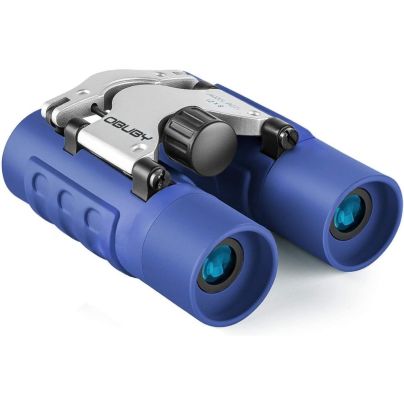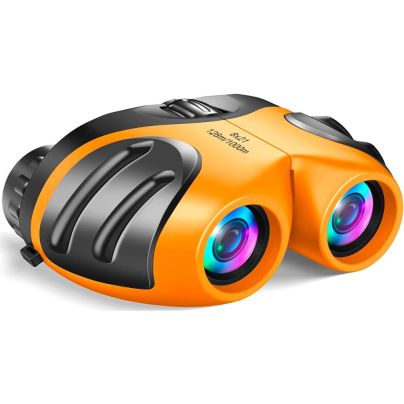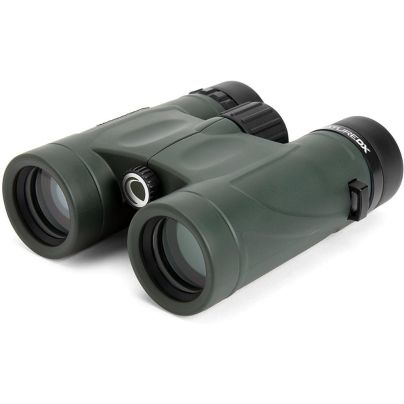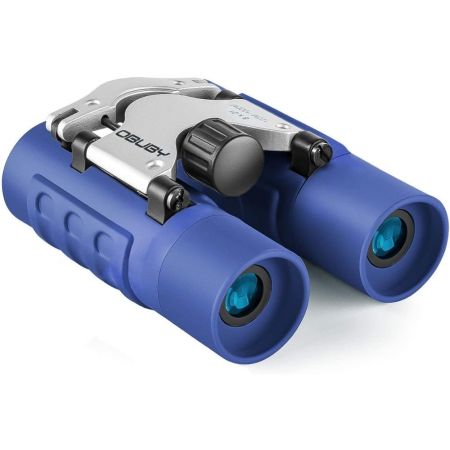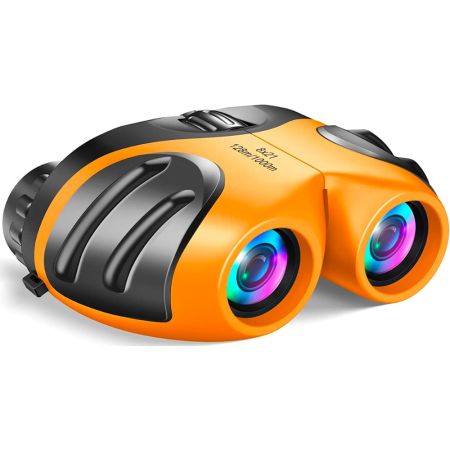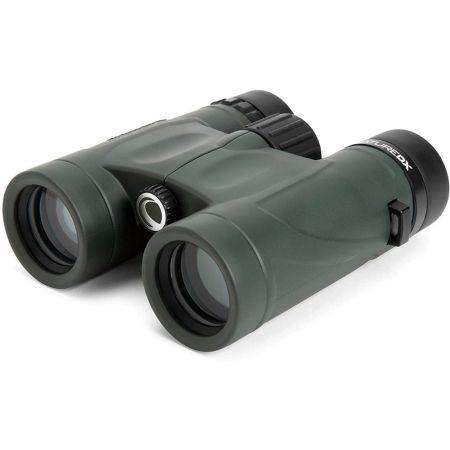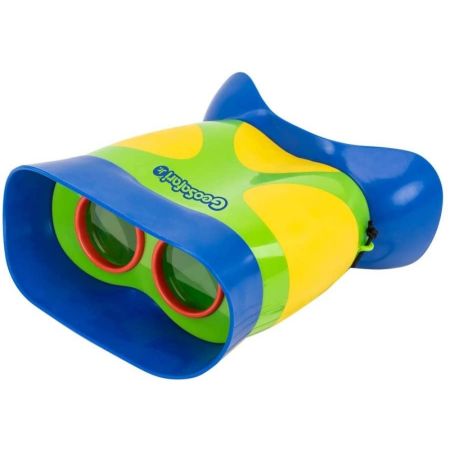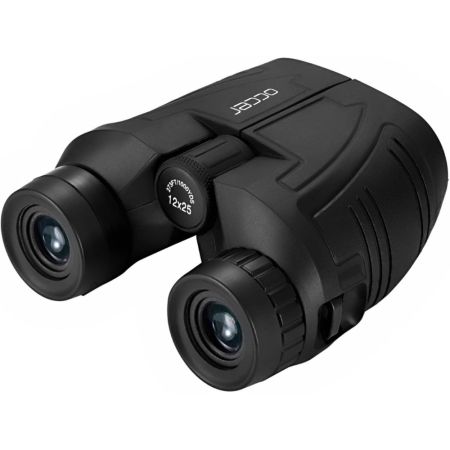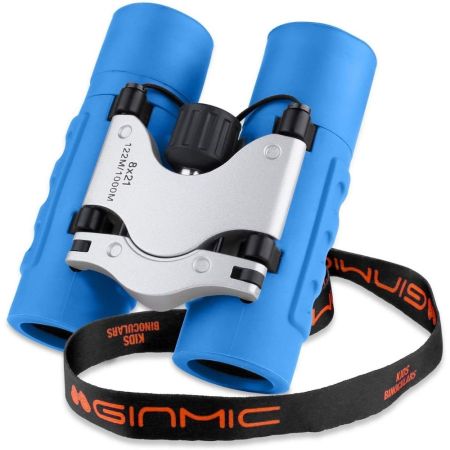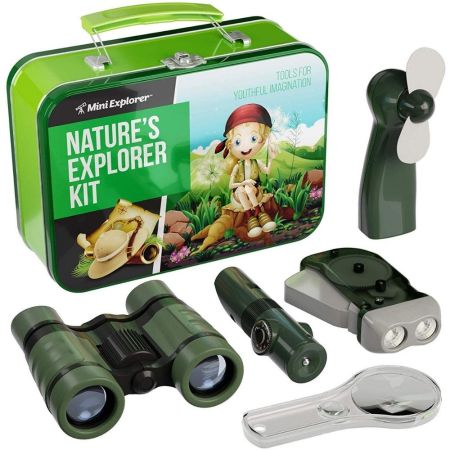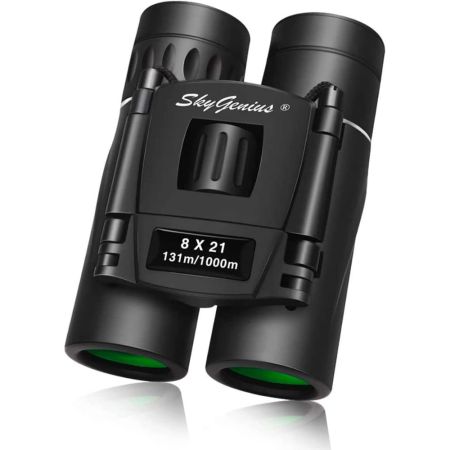We may earn revenue from the products available on this page and participate in affiliate programs. Learn More ›
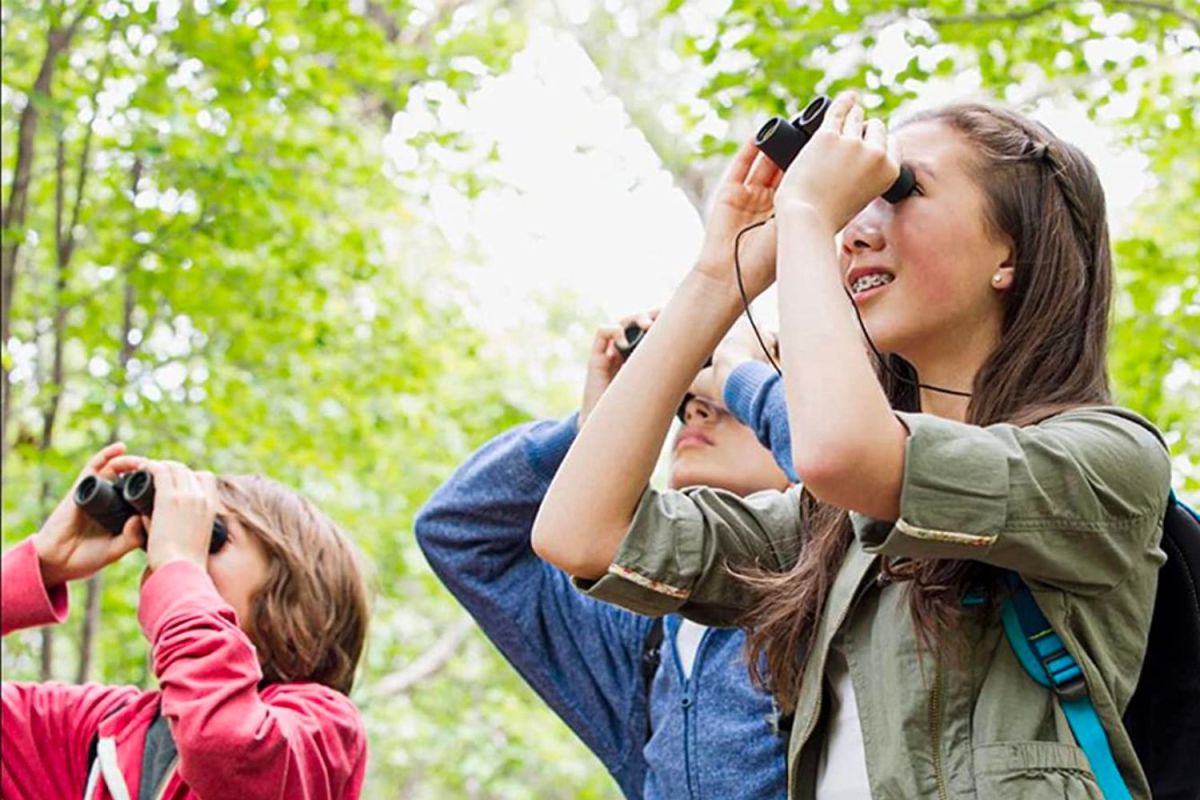
High-quality children’s binoculars are more than just a toy—they’re an educational tool that fosters an interest in the natural world. Whether they’re used for wildlife watching, hiking, fishing, bird-watching, or exploring, the best binoculars for kids are a fun and useful piece of gear for aspiring naturalists.
- BEST OVERALL: Obuby Real Binoculars for Kids
- BEST BANG FOR THE BUCK: Let’s Go! Compact Shockproof Binoculars for Kids
- UPGRADE PICK: Celestron Nature DX 8×32 Binoculars
- BEST FOR YOUNGER KIDS: Educational Insights GeoSafari Jr. Binoculars
- BEST FOR OLDER KIDS: Occer 12×25 Compact Binoculars
- BEST WATERPROOF: Ginmic 8×21 Binoculars for Kids
- BEST KIT: Mini Explorer Kit for Kids
- BEST FOR TEENAGERS: SkyGenius Binoculars
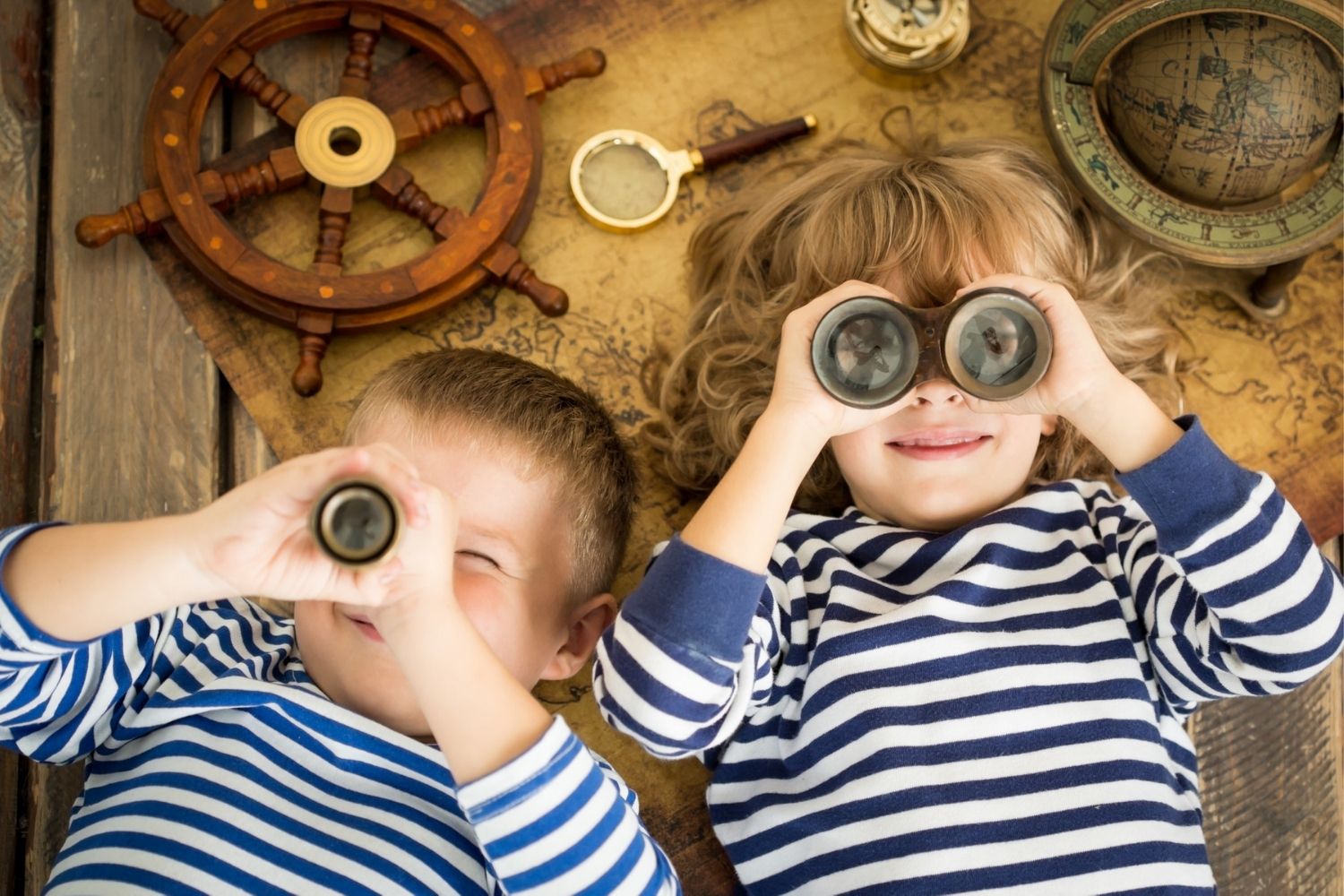
Before Buying Binoculars for Kids
It’s important to note that binoculars that are suitable for a preschooler will vary widely from binoculars that are appropriate for a preteen, so it’s important to keep the child’s age in mind when buying binoculars for kids. Most binoculars that are designed for children have between 2X and 8X magnification and an objective lens diameter of under 30 millimeters. The objective lens is the one opposite the eyepiece, and its size dictates how much light is let in. For older kids, look for products with higher magnification and larger lens diameters.
What to Consider When Choosing the Best Binoculars for Kids
While it’s easy to assume that all children’s binoculars offer similar performance, a number of factors affect their functionality. Kids’ binoculars are designed to be compact and lightweight while also being made to withstand rough treatment. Durability is a key consideration when shopping for binoculars for children because they’re likely to experience plenty of wear and tear while on outdoor adventures.
Magnification
The first number that appears on the binoculars, typically represented as “10X,” stands for magnification. In this example, 10X means 10 times magnification. The set of binoculars with the highest possible magnification is not always the best product based on how they will be used, however. Magnification level should be balanced against the diameter of the objective lens to provide a wide, clear view of whatever the user is trying to view.
Focus on finding a magnification level that is appropriate for the activity. For instance, a 10X magnification isn’t necessary for watching horse racing because all that would be visible is the horse’s head. Typical magnification ranges for binoculars include short range, medium range, and long range.
- Short range: 3X to 6X magnification
- Medium range: 7X to 9X magnification
- Long range: 10X or higher magnification
Field of View
Binoculars’ field of view refers to the horizontal measurement from one side to the other of the subject area visible at 1,000 yards. This measurement is typically taken in either feet or meters, with wider fields of view being better for following action at a distance. A field of view can also be designated as an angle, like 7 percent. This is the angle of what can be seen out of the binoculars without moving them.
Field of view is determined by the magnification level of the binoculars and the objective lens diameter. As the magnification level increases, the field of view decreases. However, when the objective lens diameter gets wider, the field of view increases. This is why it is important for shoppers to balance the objective lens diameter and the magnification level so that they do not end up seeing one thing way too closely or seeing everything in very blurry detail.
Lens Coating
Some binocular lenses come with specialized coatings applied to the glass. These coatings can serve a variety of purposes, including protecting the glass, reducing reflections and glare, improving light transmission, and improving contrast. Other coatings repel water, dirt, and grease, or emphasize a specific color, which is a great option for hunters.
Just because a product advertises that its lenses are coated doesn’t mean that the quality of the lens coating is high enough to warrant purchasing those binoculars. Stay away from very low-priced products that advertise fully coated lenses because these coatings are likely ineffective or disruptive to the clarity of the image.
Size and Weight
The size and the weight of a pair of binoculars may be an important factor if you plan to carry them with you. On average, compact binoculars weigh 1 pound or less and are typically lightweight enough to fit into a bag or be carried around the neck. Larger binoculars can weigh up to 4 pounds.
This range means that there won’t be a lot of weight fluctuation between sets of binoculars, but that doesn’t mean that users shouldn’t consider weight before they purchase them. If carrying binoculars around their neck for a long period of time, users will notice the difference between a 4-pound pair and a 1-pound pair in no time. One kid’s binoculars might not be appropriate for another child’s size or intended use.
Waterproofing
Binoculars are typically grouped into one of three categories when it comes to water resistance: water susceptible, water-resistant, and waterproof.
- Water-susceptible binoculars have no waterproofing or water-resistant features outside of the natural water resistance of the materials (like plastic or stainless steel) used in their construction. These binoculars should never be used in rainy or wet conditions and certainly not on a boat or dock.
- Water-resistant binoculars have some type of seal to prevent moisture from getting into the binocular tube. However, these binoculars are still not waterproof and should not be used on boats or in very wet conditions.
- Waterproof binoculars can be fully submerged without damage. However, the depth to which they can be submerged and the length of time they can be underwater varies. Always refer to specific manufacturer recommendations before getting binoculars wet. Also, keep in mind that “waterproof” does not necessarily mean “fogproof.” Built-up condensation in these binoculars can easily cloud the view through the eyepiece.
Additional Features
As with many gadgets, binocular manufacturers often package their products with optional features and accessories. Some of these that are most useful to binocular buyers include fogproofing, tripod adapters, neck straps, and harnesses.
- Fogproof binoculars are filled with inert gases such as nitrogen, argon, or a combination of the two. This gas is pumped into the optical tubes of the binoculars and kept under pressure to ensure the binoculars’ gaskets and other seals stay dry and in place.
- Tripod adapters are great for stationary activities like amateur astronomy. Attach the binoculars directly to the tripod and adjust the sight until it’s in the perfect position. Using a tripod is easier than holding binoculars still for long periods of time. Users won’t lose their focal point or deal with shaky vision, either.
- Neck straps and harnesses keep binoculars safe while walking, hiking, climbing, or running. Some harnesses have a stabilizing function that lets adventurers use the binoculars with almost no hand shake.
Our Top Picks
The following recommendations consider all of the key features to look for in kids’ binoculars, including size, weight, durability, and level of magnification. This list offers a variety of choices for a set of top-notch binoculars for kids to suit most needs and budgets. Read on for some recommendations for the best binoculars for kids to use on their next big expedition.
Best Overall
Obuby Real Binoculars for Kids
See ItThese durable binoculars have 8X magnification and an objective lens diameter of 21 millimeters, making them a great all-around choice for most activities. The manufacturer recommends this model for children ages 3 to 12, but toddlers may have a difficult time maintaining steady hands for viewing at 8X magnification. They have a 7.2-degree viewing angle, meaning that a child will have a wide field of view despite the compact size of the binoculars. They’re adjustable, so they can be an appropriate size for children of varying ages.
These Obuby binoculars are shockproof, waterproof, and fogproof, making them safe to use during any outdoor adventure. Rubber eye protection and a nonslip grip enhance ease of use, and the wide range of color options means that even the pickiest of kids will find a hue they like. The binoculars measure 4 inches long by 3.5 inches wide by 1.1 inches deep, weigh 5.9 ounces, and come with a cleaning cloth, a case, and a velvet bag for storage.
Product Specs
- Maximum magnification: 8X
- Recommended ages: 3 to 12
- Weight: 5.9 ounces
Pros
- Shockproof, waterproof, and fogproof
- Comes with handy accessories
- Features 8X magnification
- Appropriate for a wide age range
Cons
- May be difficult for younger children to use
Get the Obuby binoculars for kids on Amazon.
Best Bang For The Buck
Let’s Go! Compact Shockproof Binoculars for Kids
See ItThese kid-friendly binoculars have a layer of rubber surrounding the eyepieces, which makes them comfortable to use and also protects the lenses from damage. They’re also shockproof for added durability. They offer 8X magnification, have an objective lens diameter of 21 millimeters, and provide a 7.2-degree viewing angle. They’re ergonomically designed to fit perfectly in a child’s hand and also have a nonslip grip. The lenses are coated with antireflective layers, ensuring that the resulting image is crisp and colorful.
They measure 4 inches long by 3 inches wide by 2 inches deep, weigh 5.6 ounces, and are recommended for kids ages 3 and up. They’re available in a rainbow of 10 colors.
Product Specs
- Maximum magnification: 8X
- Recommended ages: 3+
- Weight: 5.6 ounces
Pros
- Affordable price
- Available in 10 colors
- Ergonomically designed for optimal comfort
- Shockproof and waterproof
Cons
- Some users complain of poor durability
Get the Let’s Go! binocular for kids on Amazon.
Upgrade Pick
Celestron Nature DX 8×32 Binoculars
See ItOlder children or preteens who are looking to upgrade from binoculars that were specifically designed for children might be interested in this pair from Celestron. Because of their design, features, and high quality, they can be shared with other members of the family—no matter what their age is. They have 8X-magnification power and are multicoated for optimal color and contrast, making them a good choice for aspiring birders.
The objective lens diameter is 32 millimeters. They also have a high level of waterproofing and fogproofing, ensuring that the lenses won’t fog up regardless of poor weather conditions. The twist-up eye caps make them comfortable for those who wear glasses to use. With the brand’s tripod adapter, they can be mounted to a tripod or monopod for steadier viewing.
They come with objective lens caps, an eyepiece rain guard, a neck strap, and a lens cloth. They weigh 1.25 pounds and measure 5 inches long by 4.9 inches wide by 1.8 inches deep.
Product Specs
- Maximum magnification: 8X
- Recommended age: N/A
- Weight: 20 ounces
Pros
- Waterproof and fogproof
- Comes with useful accessories
- Comfortable for those who wear glasses
- Can be mounted to a tripod
Cons
- High price
- May not be suitable for younger children
Get the Celestron binoculars for kids on Amazon or at The Home Depot.
Best for Younger Kids
Educational Insights GeoSafari Jr. Binoculars
See ItLittle kids may be interested in using their older siblings’ or parents’ binoculars but could easily become frustrated if they’re not able to adjust them to see clearly. These binoculars from Educational Insights, however, were specifically designed with younger children in mind. They offer 2X magnification, which means that a toddler or preschooler will be able to have a steady view even if they’re still a little wobbly on their feet. They have a large eyepiece and don’t require focus adjustments, meaning they’re easy and comfortable to use for youngsters. They’re recommended for children ages 3 and up. They weigh 4.8 ounces and measure 7 inches long by 5.75 inches wide by 2.8 inches deep.
Product Specs
- Maximum magnification: 2X
- Recommended ages: 3+
- Weight: 4.8 ounces
Pros
- Offers steady magnification for young children
- No focus adjustments required
- Large eyepiece facilitates ease of use
Cons
- Only suitable for younger children
Get the Educational Insights binoculars for kids on Amazon or at Educational Insights.
Best for Older Kids
Occer 12×25 Compact Binoculars
See ItThese compact binoculars from Occer are marketed for both kids and adults. They make a versatile choice for parents who want to share their set with their older children.
The higher the magnification, the steadier a hand needs to be, and since this set of binoculars has 12X magnification, they’re best used in a stationary position rather than on the move. It also means these aren’t well suited for younger kids who may not be able to provide the necessary stability to get a clear image. They have a 25-millimeter objective lens diameter and adjustable eyecups, making them a good choice for anyone who wears glasses. The lenses are coated with a fully multi-coated multilayer broadband green film, resulting in a colorful and crisp image. They also have a wide viewing angle of 7.5 degrees. They’re shockproof and have a secure grip along with light waterproofing.
These lightweight binoculars weigh in at just 0.65 pounds and measure 4 inches long by 4.4 inches wide by 1.9 inches deep.
Product Specs
- Maximum magnification: 12X
- Recommended age: N/A
- Weight: 10.4 ounces
Pros
- Features high level of magnification
- Compact, lightweight design
- Shockproof and water-resistant
Cons
- May be difficult for younger children to use
Get the Occer binoculars for kids on Amazon.
Best Waterproof
Ginmic 8×21 Binoculars for Kids
See ItWaterproofing is an important consideration if your child will be using their binoculars on fishing or camping trips where splashes and spills are inevitable. This set is waterproof, shockproof, and fogproof, meaning it can handle most weather conditions. They have 8X magnification and the focus can be adjusted on the eyepiece, making them a good pick for older kids. They have an objective lens diameter of 21 millimeters.
They come with a standard carrying strap, a wide neck strap, and a lens cleaning cloth. Plus, they’re available in eight fun colors to suit your child’s preferences. While the manufacturer’s recommended age range is 3 to 12, these binoculars are best suited to school-age kids. They’re lightweight at 6 ounces and measure 4.33 inches long by 3.54 inches wide by 1.97 inches deep.
Product Specs
- Maximum magnification: 8X
- Recommended ages: 3 to 12
- Weight: 6 ounces
Pros
- Shockproof, waterproof, and fogproof
- Includes carrying strap and lens cleaning cloth
- Available in a range of colors
Cons
- May be difficult for younger children to use
Get the Ginmic binoculars for kids on Amazon.
Best Kit
Mini Explorer Kit for Kids
See ItThis Mini Explorer kit is a great starter set for a budding naturalist. It includes a high-quality set of binoculars along with a magnifying glass, a self-energizing flashlight, a handheld fan, and a multi-tool that contains a compass, a thermometer, and a whistle. It all fits neatly in a carrying case with a locking mechanism.
The binoculars offer 4X magnification, making them a good choice for younger children. They have an objective lens diameter of 30 millimeters, meaning they let in plenty of light. They have a focus wheel, soft rubber handles, and comfortable eyepieces.
Product Specs
- Maximum magnification: 4X
- Recommended ages: 6+
- Weight: 13.8 ounces
Pros
- Comes with a compass, flashlight, and magnifying glass
- Everything fits into a convenient carrying case
- 4X lens magnification is great for younger children
Cons
- Only suitable for younger children
Get the Mini Explorer Kit on Amazon.
Best for Teenagers
SkyGenius Binoculars
See ItThese pocket-size binoculars are affordable yet effective, making them a great choice for teens who are newly interested in bird-watching or other outdoor activities. They offer 8X magnification and a 21-millimeter objective lens length, which allows users to have a clear view of objects up to 1,000 yards away.
The lens features a coating that increases brightness and clarity, ensuring that the image is as realistic as possible. One feature that makes these binoculars particularly easy to use is their central focus knob, which is simple to operate and suitable for beginners. A carrying bag, cleaning cloth, and strap are included with each set.
Product Specs
- Maximum magnification: 8X
- Recommended age: N/A
- Weight: 6 ounces
Pros
- Compact and lightweight design
- Comes with handy accessories
- Easy to focus with a central knob
Cons
- May be difficult for younger children to use
Get the SkyGenius binoculars for kids on Amazon.
Our Verdict
After reviewing this guide, you now know more about shopping for binoculars for kids. We recommend the Obuby binoculars for kids as our top pick for its durable construction and midrange price. Those on a budget may appreciate the Let’s Go! binoculars for kids, which offer terrific performance at a lower price point.
How We Chose the Best Binoculars for Kids
Extensive product research went into creating this guide. We explored more than 20 binocular options and weighed a number of practical considerations before making our recommendations.
- Durability: Binoculars should stand up to lots of wear and tear—especially if they’re being used by children. For that reason, we prioritized durability when making our picks.
- Magnification: When choosing binoculars, magnification is a major factor. With increased magnification, however, comes decreased stability and ease of use. We included binoculars with varying ranges of magnification in order to provide options for both younger and older children.
- Age range: This guide covers products suitable for both toddlers and teenagers, so we made sure to include binoculars designed for a wide range of ages and ability levels.
Tips for Using Binoculars for Kids
Binoculars can be tricky to use, especially for younger children. Following these tips will make the experience more successful and enjoyable.
- Choose the right magnification level: Binoculars with lower levels of magnification will be easier to use for younger children.
- Choose a lightweight pair: Heavy binoculars will be difficult for young children to hold in place.
- Adjust the interpupillary distance: Help your child to ensure a proper view by adjusting the binoculars so that they are properly positioned.
- Wear the strap: Most binoculars come with a neck strap to ensure the binoculars aren’t dropped.
- Stay still: For children, it’s important to stand still while using binoculars in order to ensure a clear image.
FAQs
While you now know more about selecting binoculars for kids, you may still have some questions. Here are answers to some common questions people have about kid-friendly binoculars.
Q. At what age can a child use binoculars?
Children as young as 3 years old can use binoculars that are designed for young children.
Q. What is a good magnification for kids’ binoculars?
An 8X magnification is standard for basic binoculars, but 2X or 4X magnification is better for younger children because it allows them to see a clear and stable image.
Q. How do I teach my child to use binoculars?
Choose binoculars with an age-appropriate magnification level and help the child adjust them to fit their eyes. Have them stand still and choose an object at a middle distance. Ask them to look at the object without the binoculars and then slowly raise the binoculars to their eyes, asking them to keep focusing on the same object.
